
I Have a Dream Speech. Martin Luther King's Address at March on Washington, August 28, 1963. Washington, D.C.
- Subject:
- History
- Material Type:
- Primary Source
- Date Added:
- 06/02/2022

I Have a Dream Speech. Martin Luther King's Address at March on Washington, August 28, 1963. Washington, D.C.

Students will identify how Martin Luther King Jr's dream of nonviolent conflict-resolution is reinterpreted in modern texts. Homework is differentiated to prompt discussion on how nonviolence is portrayed through characterization and conflict. Students will be formally assessed on a thesis essay that addresses the Six Kingian Principles of Nonviolence.

A recording and transcript of Martin Luther King Jr.'s celebrated "I Have a Dream" speech, delivered on Aug. 28, 1963, on the steps of the Lincoln Memorial.
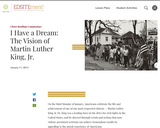
On the third Monday of January, Americans celebrate the life and achievement of one of our most respected citizens -- Martin Luther King, Jr.

Ideologies of political parties in the United States. General views of liberals (generally associated with the Democratic Party) and conservatives (generally associated with the Republican Party).

This activity is designed to accompany the contextual essay “‘I’m No Lady, I’m a Member of Congress’: Women Pioneers on Capitol Hill, 1917–1934,” from the Women in Congress website, history.house.gov/ exhibition-and publications/wic/women-in-congress/. Students have the opportunity to learn more about the women who served in Congress from 1917 to 1934. Students are encouraged to analyze the role women Representatives and Senators played in Congress during this era, as well as the ways in which they may have changed the institution.

Earl Ubell is a pioneer among science and health writers in America. After a long, distinguished career at The New York Herald Tribune from 1943 to 1966, he went on to work at both CBS and NBC News. Prominent in the emerging scientific writing community in the 1950s and early 1960s, he was a recipient of the Lasker Medical Journalism Award 1957. Milton Stanley Livingston was a leading physicist in the field of magnetic resonance accelerators. Working first with professor Ernest O. Lawrence at the University of California, Livingston was instrumental in the development of the Berkeley cyclotron. Moving to Cornell in 1938, Livingston was part of the core group who established nuclear physics as a field of study. Choosing to stay with the Cornell cyclotron rather than follow colleagues onto the Manhattan Project, Livingston was involved in the production of radioisotopes for medical purposes. At the time of this interview, Livingston was director of the Cambridge Electron Accelerator, a joint project of Harvard University and MIT.In this program segment Louis Lyons quizzes Earl Ubell about the lack of public knowledge and the perception of the nuclear bomb, while pressing Professor Livingston to explain exactly what nuclear fallout is, and the danger it presents.
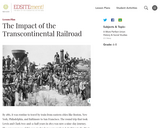
Students analyze archival material such as photos, documents, and posters, to understand the who was involved in constructing, and the lasting phenomenon of, the Transcontinental Railroad.

Learn about the women who carved a path for future female advocates, judges, and Supreme Court Justices.

Ben, an enslaved miller at Mount Vernon, discusses freedom. In a reenactment of him thinking aloud, he considers what his life might be like if he runs away from Mount Vernon and gains his freedom as compared to his current life as George Washington's miller.
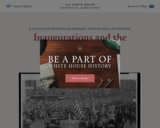
An inauguration is the act or ceremony of bringing someone into a position or an office. Every president of the United States has been inaugurated, dating back to the first executive, George Washington. These inaugurations symbolize a peaceful transition of power between administrations. Although the Constitution provides an oath for the new president to take, all other elements of the modern presidential inauguration grew from traditions, changes, and preferences that evolved over 200 years. As the president's residence, the White House plays an important role in inaugurations. Gain a deeper appreciation of presidential inaugurations and transitions at the White House by learning about the history behind the Oath of Office, inaugural parade, parties, and more.

David Armitage, Lloyd C. Blankfein Professor of History at Harvard University, briefly explores some less obvious aspects of the Declaration of Independence, while also pointing to some of the later declarations heavily influenced by the American document.
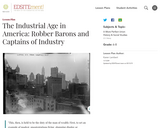
How shall we judge the contributions to American society of the great financiers and industrialists at the end of the nineteenth and beginning of the twentieth centuries? In this lesson, students explore a variety of elementary historical sources to uncover some of the less honorable deeds as well as the shrewd business moves and highly charitable acts of the great industrialists and financiers, men such as Andrew Carnegie, J. Pierpont Morgan, John D. Rockefeller, and Cornelius Vanderbilt.
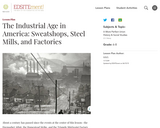
About a century has passed since the events at the center of this lesson-the Haymarket Affair, the Homestead Strike, and the Triangle Shirtwaist Factory Fire. In this lesson, students use elementary historical sources to explore some of the questions raised by these events, questions that continue to be relevant in debates about American society: Where do we draw the line between acceptable business practices and unacceptable working conditions? Can an industrial-and indeed a post-industrial-economy succeed without taking advantage of those who do the work?

This PBL plan provides a comprehensive, interdisciplinary approach for students to explore the Industrial Revolution's legacy and its relevance to today's world.Project-Based Learning (PBL) Plan: The Industrial RevolutionDriving QuestionHow did the Industrial Revolution transform societies, economies, and environments, and what lessons can we apply to address today's global challenges?Real World InvestigationProject Overview: Students will investigate the multifaceted impacts of the Industrial Revolution on societies, economies, and environments. They will explore how these historical changes relate to current global challenges, such as industrialization, urbanization, environmental sustainability, and social equity. The investigation will culminate in a multimedia presentation or exhibit showcasing their findings and proposed solutions for contemporary issues inspired by the lessons of the Industrial Revolution.

This encyclopedia entry provides information about the growth of industry, the dispersion of industry, and industrial combinations in the late 19th century.

On February 2, 2023, our curators discussed Benjamin Franklin’s copy of the US Constitution and Jean-Antoine Houdon’s bust of Franklin. They were joined by Liz Covart (Founding Director, Colonial Williamsburg Innovation Studios) and Sara Charles (Education Program Manager, Gilder Lehrman Institute). This program was generously sponsored by The Fund for the Endowment of the Diplomatic Reception Rooms.

Originally broadcast on September 17, 2020, this session of Inside the Vault: Highlights from the Gilder Lehrman Collection celebrated Constitution Day with rare materials from the Gilder Lehrman Collection: The US Constitution! Gilder Lehrman's curators were joined by Conroe Brookes from Hamilton, and Kevin Cline, 2016 National History Teacher of the Year, to explore these rare documents, learn about their creation, take a close look at how the preamble changed between the first draft and the final copy, and what the Constitution says about voting.

On May 4, 2023, our curators were joined by Dr. Andrew Robertson (The Graduate Center and Lehman College, CUNY) to discuss materials related to eighteenth- and nineteenth-century voting rights. Dr. Robertson explained how voting rights were expanded and contracted, from the Revolutionary era through the Civil War and Reconstruction.

This informational research lesson utilizes an interactive timeline as a tool for students to organize their research in an appealing way. Students will research bookmaking technology milestones from the Egyptian, Hittite, Chinese, and European cultures. Students will also learn about and practice citing and attributing websites and images, and create a bibliography.